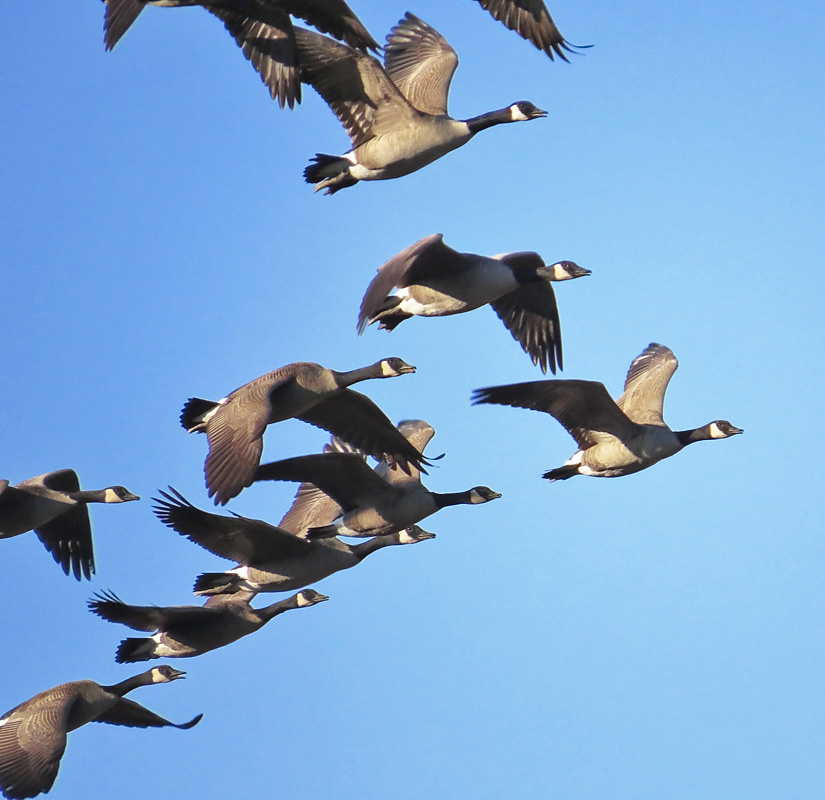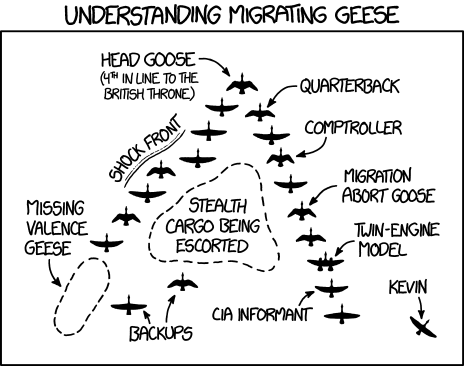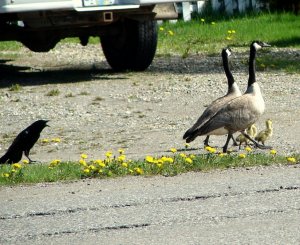You are using an out of date browser. It may not display this or other websites correctly.
You should upgrade or use an alternative browser.
You should upgrade or use an alternative browser.
Honk, If You Like Geese!
- Thread starter Meanderer
- Start date
Timetrvlr
Member
- Location
- central interior B.C., Canada
Camper6
Well-known Member
- Location
- Northwestern Ontario Canada
They are a nuisance where I live. The golf course is their favorite stamping grounds.
Anywhere where the grass is cut low and water is nearby is where they hang out and they make a terrible mess and it's not sanitary because people track it on their shoes.
The local hospital had to do something about it. I don't know what they did but the geese are gone.
Anywhere where the grass is cut low and water is nearby is where they hang out and they make a terrible mess and it's not sanitary because people track it on their shoes.
The local hospital had to do something about it. I don't know what they did but the geese are gone.
Ruth n Jersey
Well-known Member
- Location
- Northern New Jersey
I like to watch the geese also. They sure can make a mess of the beaches around the lakes by us. The water along the shore can be pretty bad. A couple of times they shut down the public beach so they could clean up. Once they tried noise makers. It worked for a little while but I think they got use to it.
Uncontrolable
Member
- Location
- Tucson Az
You force me to tell a geese story. If the Beatles were named after birds instead of insects their hit song would have been: "Give Geese a Chance".
Meanderer
Supreme Member
Leadership Lessons from Geese by Joel Garfinkle

"As leaders, we can learn a lot from the goose. Geese are intriguing creatures and while considered
pests in certain situations, they also have an incredibly strong sense of family and group loyalty. Probably one of the most phenomenal geese facts is that their desire to return to their birth place every year is so strong that they will often fly up to 3,000 miles to get there".
"As you consider these fascinating facts, think about how you could apply these lessons to incorporate a bit of goose behavior into developing leadership skills to create your own style".
"Fact 1: As each goose flaps its wings, it creates an uplift for the birds that follow. By flying in V formation, the whole flock adds 71% greater flying range than if each bird flew alone.
Lesson: People who share a common direction and sense of community can get where they are going quicker and easier, because they are traveling on the thrust of one another".
"Fact 2: When a goose falls out of formation, it suddenly feels the drag and resistance of flying alone. It quickly moves back into formation to take advantage of the lifting power of the bird immediately in front of it.
Lesson: If we have as much sense as a goose, we stay in formation with those headed where we want to go. We are willing to accept their help, and we give our help to others".
"Fact 3: When the lead goose tires, it rotates back into the formation and another goose flies to the point position.
Lesson: It pays to take turns doing the hard tasks and sharing leadership. As with geese, people are interdependent on each other’s skills, capabilities, and unique arrangement of gifts, talents, or resources".
"Fact 4: The geese flying in formation honk to encourage those in front to keep up their speed.
Lesson: We need to make sure our honking is encouraging. In groups where there is encouragement, the production is greater. The power of encouragement (to stand by one’s heart or core values and encourage the heart and core of others) is the quality of honking we seek".
"Fact 5: When a goose gets sick, wounded, or shot down, two geese drop out of formation and follow it down to help or protect it. They stay with it until it dies or is able to fly again. Then they launch out with another formation or catch up with the flock.
Lesson: If we have as much sense as geese, we will stand by each other in difficult times as well as when we are strong".
(This was transcribed from a speech given by Angeles Arrien at the 1991 Organizational Development Network, based on the work of Milton Olson).

"As leaders, we can learn a lot from the goose. Geese are intriguing creatures and while considered
pests in certain situations, they also have an incredibly strong sense of family and group loyalty. Probably one of the most phenomenal geese facts is that their desire to return to their birth place every year is so strong that they will often fly up to 3,000 miles to get there".
"As you consider these fascinating facts, think about how you could apply these lessons to incorporate a bit of goose behavior into developing leadership skills to create your own style".
"Fact 1: As each goose flaps its wings, it creates an uplift for the birds that follow. By flying in V formation, the whole flock adds 71% greater flying range than if each bird flew alone.
Lesson: People who share a common direction and sense of community can get where they are going quicker and easier, because they are traveling on the thrust of one another".
"Fact 2: When a goose falls out of formation, it suddenly feels the drag and resistance of flying alone. It quickly moves back into formation to take advantage of the lifting power of the bird immediately in front of it.
Lesson: If we have as much sense as a goose, we stay in formation with those headed where we want to go. We are willing to accept their help, and we give our help to others".
"Fact 3: When the lead goose tires, it rotates back into the formation and another goose flies to the point position.
Lesson: It pays to take turns doing the hard tasks and sharing leadership. As with geese, people are interdependent on each other’s skills, capabilities, and unique arrangement of gifts, talents, or resources".
"Fact 4: The geese flying in formation honk to encourage those in front to keep up their speed.
Lesson: We need to make sure our honking is encouraging. In groups where there is encouragement, the production is greater. The power of encouragement (to stand by one’s heart or core values and encourage the heart and core of others) is the quality of honking we seek".
"Fact 5: When a goose gets sick, wounded, or shot down, two geese drop out of formation and follow it down to help or protect it. They stay with it until it dies or is able to fly again. Then they launch out with another formation or catch up with the flock.
Lesson: If we have as much sense as geese, we will stand by each other in difficult times as well as when we are strong".
(This was transcribed from a speech given by Angeles Arrien at the 1991 Organizational Development Network, based on the work of Milton Olson).
Last edited:
Uncontrolable
Member
- Location
- Tucson Az
I love hearing about the intelligence of animals. Too often animal intelligence is compared to humans. Humans are usually put at the top of the evolution scale. Yet evolution is about survival. If survival is the main measure humans fall far behind. Bacteria have lived maybe billions of years. Dogs are smart enough to read our expressions. They put on special faces for us. Like the face with that longing, very lovable look that is telling you to give them a treat. You get the picture.Leadership Lessons from Geese by Joel Garfinkle

"As leaders, we can learn a lot from the goose. Geese are intriguing creatures and while considered
pests in certain situations, they also have an incredibly strong sense of family and group loyalty. Probably one of the most phenomenal geese facts is that their desire to return to their birth place every year is so strong that they will often fly up to 3,000 miles to get there".
"As you consider these fascinating facts, think about how you could apply these lessons to incorporate a bit of goose behavior into developing leadership skills to create your own style".
"Fact 1: As each goose flaps its wings, it creates an uplift for the birds that follow. By flying in V formation, the whole flock adds 71% greater flying range than if each bird flew alone.
Lesson: People who share a common direction and sense of community can get where they are going quicker and easier, because they are traveling on the thrust of one another".
"Fact 2: When a goose falls out of formation, it suddenly feels the drag and resistance of flying alone. It quickly moves back into formation to take advantage of the lifting power of the bird immediately in front of it.
Lesson: If we have as much sense as a goose, we stay in formation with those headed where we want to go. We are willing to accept their help, and we give our help to others".
"Fact 3: When the lead goose tires, it rotates back into the formation and another goose flies to the point position.
Lesson: It pays to take turns doing the hard tasks and sharing leadership. As with geese, people are interdependent on each other’s skills, capabilities, and unique arrangement of gifts, talents, or resources".
"Fact 4: The geese flying in formation honk to encourage those in front to keep up their speed.
Lesson: We need to make sure our honking is encouraging. In groups where there is encouragement, the production is greater. The power of encouragement (to stand by one’s heart or core values and encourage the heart and core of others) is the quality of honking we seek".
"Fact 5: When a goose gets sick, wounded, or shot down, two geese drop out of formation and follow it down to help or protect it. They stay with it until it dies or is able to fly again. Then they launch out with another formation or catch up with the flock.
Lesson: If we have as much sense as geese, we will stand by each other in difficult times as well as when we are strong".
(This was transcribed from a speech given by Angeles Arrien at the 1991 Organizational Development Network, based on the work of Milton Olson).
Falcon
DV8
- Location
- So. California
Meanderer, Thanks for the info on geese. Seems they are faithful to one another. Very interesting.
Meanderer
Supreme Member
Most of my observations of geese, have been from a distance. We live near a dairy farm, and have fields of crops all around us. It is funny to watch them cross the road. to join other groups of geese, for the next course. While they feed, it always seems that some have sentry duty, and keep their heads up and necks straight, as they look around. I find it magical, to be out in our yard, in the early morning or on a quiet evening and hear them honking, loudly and see them as they fly low overhead, on their way....
Last edited:
Jackie22
Well-known Member
- Location
- Northeast Texas
Yes, Interesting thread.........thanks Meanderer
RadishRose
SF VIP
- Location
- Connecticut, USA
That was amazing Meanderer! I never those flying facts about geese. Beautiful video with a beautiful message. Thanks!
Uncontrolable
Member
- Location
- Tucson Az
Nice video. People need to respect all living things. I like what Native American believe. They believe all things are sacred and should be given the greatest respect. In our sweat lodge, if we found an insect inside the lodge we would pick it up and sit it safely out side. Killing anything was not allowed in ceremony.
Uncontrolable
Member
- Location
- Tucson Az
Nice.Good Question.....

Uncontrolable
Member
- Location
- Tucson Az
I like the picture where they are just taking off. They appear as if they were already in a V formation and just took off that way.







